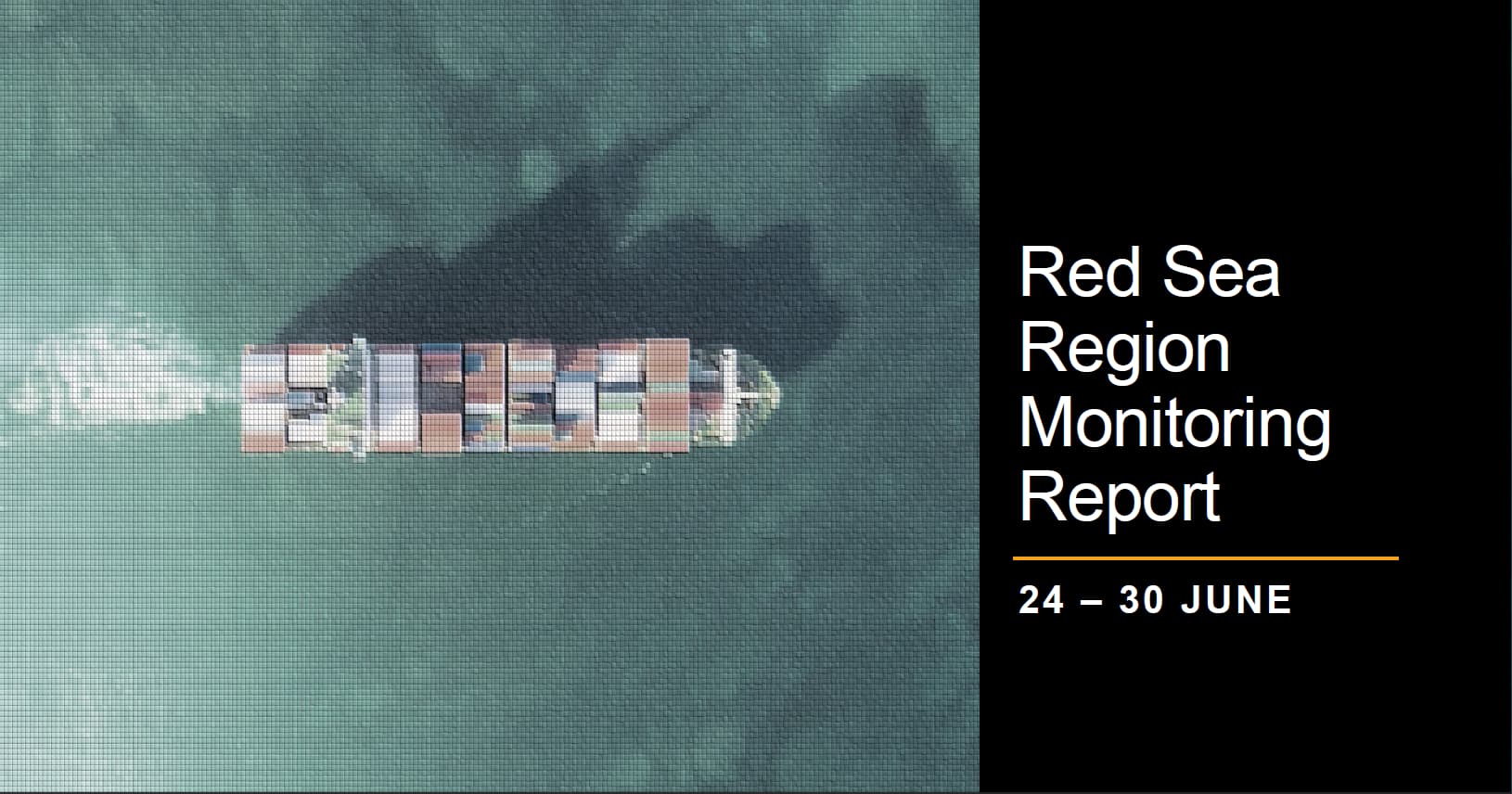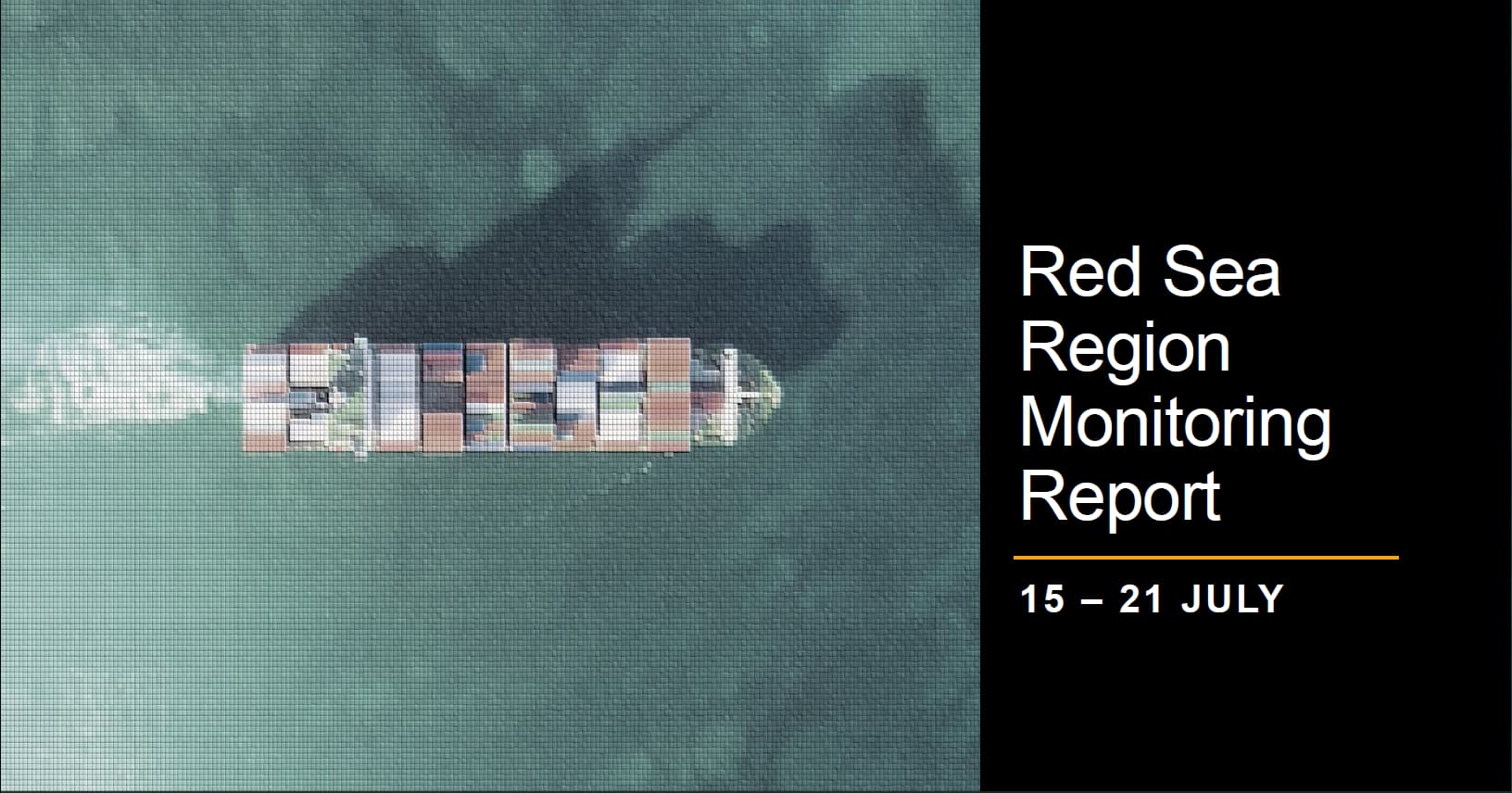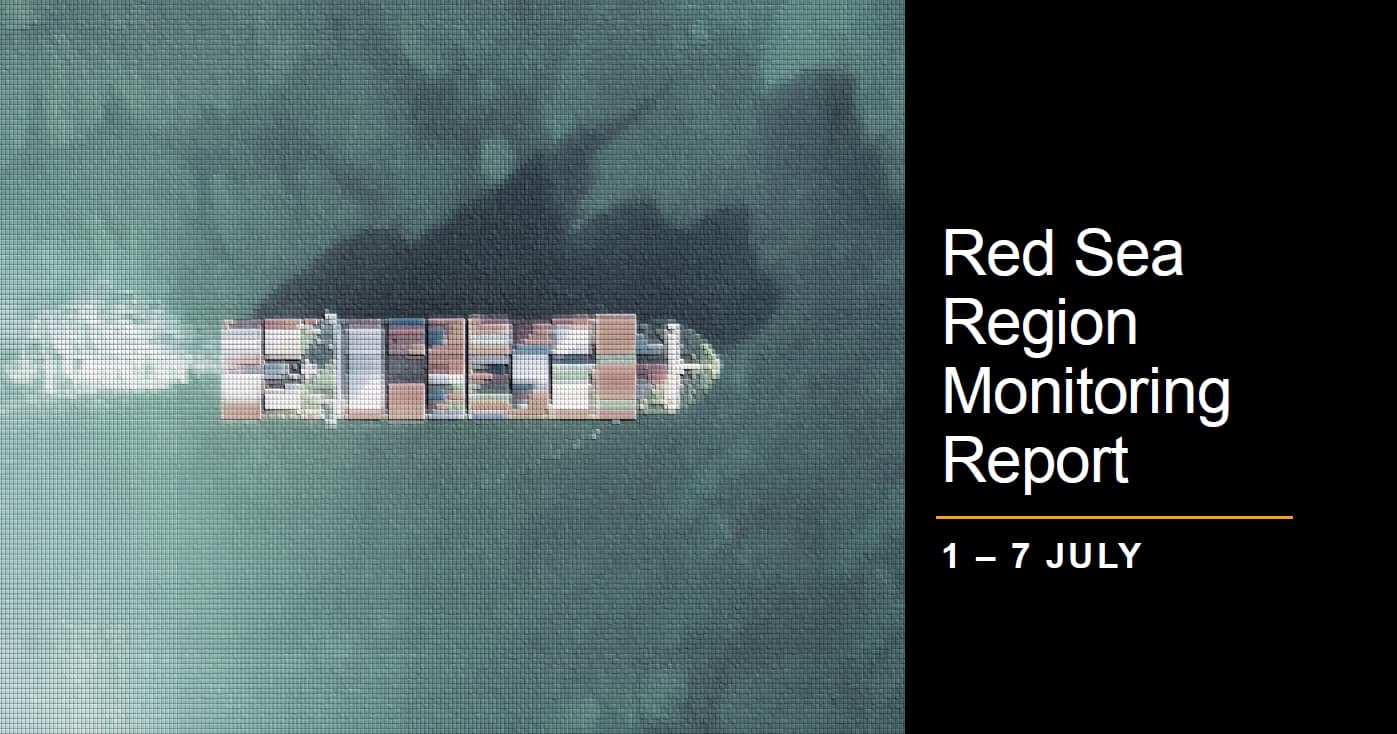KEY DEVELOPMENTS – COMMERCIAL INCIDENTS
During the monitoring period 29 April – 5 May Regal Maritime Solutions (RMS) identified the following incidents in the Red Sea and Gulf of Aden region:
MISSILE STRIKE: On 29 April an incident occurred 54NM north-west of Al Mukha, Yemen in the Red Sea an explosion was reported in close proximity to a commercial vessel Cyclades. The vessel reportedly sustained damage but confirmed the crew were safe before continuing to its next port of call.
UAV ATTACK: On 26 April (reported on 30 April) at approximately 2200 UTC an unmanned aerial vehicle (UAV) attacked the commercial vessel MSC Orion around 170NM south-east off the island of Socotra, Yemen and 300-400NM off the horn of Africa whilst transiting the Indian ocean. The vessel and crew were reported safe and continued onto its next port of call.
UAV CRASH: On 3 May a Houthi UAV reportedly landed in the northern Somalia town of Taleh. It is unclear what the original intended target was in the area. Its believed it maybe be associated to Houthi efforts to target shipping further afield in the Indian ocean.
IRANIAN INTELLIGENCE VESSEL: There have been no updates on the Iranian intelligence vessel the Behshad. Its last reported location was on 18 April in the Persian Gulf in Iranian territorial waters. It was located in the vicinity of coordinates 26° 59′ 26.2″ N, 056° 24′ 35.2″ E located approximately 5NM south of Banda Abbas, Iran and south west of the island of Hormuz.

KEY DEVELOPMENTS – MILITARY ACTIVITY
During the monitoring period 29 April – 5 May RMS identified the following incidents involving US coalition forces in the Red Sea and Gulf of Aden region, obtained from military and open sources:
MISISLE INTERCEPT: On 29 April between 1000 – 1720 local time, Houthi militants launched three anti-ship ballistic missiles (ASBM) and three UAVs from Yemen into the Red Sea towards the MV Cyclades, a Malta-flagged, Greece-owned vessel. Initial reports indicate there were no injuries and the vessel continued on its way.
UAV INTERCEPT: On 29 April around 0750 local time, US forces engaged and destroyed a Houthi launched UAV on a flight path towards USS Philippine Sea and USS Laboon in the Red Sea after it was considered as presenting an imminent threat to US, coalition and commercial vessels in the area. There were no reported injuries or damage by US or coalition naval vessels.
USV INTERCEPT: On 30 April at approximately 1350 local time, US forces engaged and destroyed an uncrewed surface vessel (USV) in Houthi-controlled areas of Yemen, considered a credible and direct threat to vessels in the region.
UAV INTERCEPT: On 2 May at around 1400 local time US forces engaged and destroyed three uncrewed aerial vehicles and systems (UAV) in Houthi controlled area of Yemen. It was determined these systems presented an imminent threat to US and coalition forces, and commercial vessels in the region.
MILITARY EXERCISE: On 5 May the Kingdom of Saudi Arabia (KSA), the United Arab Emirates, and U.S. Marine Corps launched Exercise “Native Fury 24” at a Saudi Naval Port aimed a closer military training, cooperation and interoperability amongst regional partners. The exercise coincides with the Joint Arab naval exercise known as “Red Wave 7” involving wider elements of the Saudi armed and border forces alongside Red Sea nations such as Egypt, Djibouti, Yemen and Jordan. power abroad and conduct advanced training in cooperation with our partners across the region aimed at protecting shipping routes, tackling smuggling, terrorism, piracy and illegal immigration.

KEY DEVELOPMENTS – HOUTHI MISSILE STATISTICS

Figures 1 and 2 identifies the number of missiles, UAV, USVs and UUVs launched, or prepared to be imminently launched, by Houthi militants from Yemen targeting commercial and naval vessels in the Red Sea and Gulf of Aden regions. Figures have incorporated statistics from vessels hit, near misses and pre- emptive strikes on-land in Yemen by US-led Coalition forces but not those resulting from large scale coordinated military action. In some cases the destined target of Houthi weapons including destroyed on-land in Yemen cannot not be verified and has therefore been categorised as ‘Not Known’ (NK). Where no dates are provided there were no reported incidents or data available for that period.
ANALYSIS: Houthi missile and UAV launches have recommenced but not at the intensity or tempo observed in February and March. This follows a period of continued pre-emptive US airstrikes on weapons sites and caches in Houthi controlled areas of Yemen and Houthi participation in airstrikes on Israel as part of the Iran attack in April. US–led airstrikes on Houthi targets is partially reflected in the ‘Not Known’ category in figures 1 and 2, where Houthi missiles/UAV/USVs destroyed on land with unattributed target destinations are included.
KEY DEVELOPMENTS – SECURITY INCIDENT MAPPING

REGIONAL DEVELOPMENTS
During the monitoring period 29 April – 5 May RMS identified the following key regional developments:
The Houthi UAV attack on the MSC Orion in the Indian ocean reinforced their previous threat in March to target vessels beyond the Red Sea and Gulf of Aden region by targeting shipping in the Indian ocean and Arabian Sea. This threat included targeting vessels utilising the Cape of Good Hope trade route.
The attack demonstrates the groups longer range capability and thus expands the maritime risk to shipping from potential Houthi strikes. This may result in ships with high- risk target profiles such as Israeli, US and UK linked vessels to take routes further from Yemen.
Houthi militants have warned that the next phase of their pro-Palestine campaign will involve targeting all vessels enroute to Israel that come within range of its weaponry. This includes vessels in the eastern Mediterranean and any companies interacting with Israel should the Gazan city of Rafah be attacked by Israeli forces.
The Houthis in Yemen have been establishing a closer partnership with the local Al- Qaeda branch, Al-Qaeda in the Arabian Peninsula (AQAP) which may further destabilise the country. The Houthis are known to have established joint training camps together and have extended assistance further through the provision of UAVs and releasing key figures from prison. Whilst both groups come from different branches of Islam – the Houthis being Shia and AQAP Sunni – they appear to be working more closely to take control of southern Yemen which is currently controlled by the from the UAE-backed secessionist Southern Transitional Council (STC).
The Israeli Defense Forces (IDF) intend to order thousands of Palestinians to evacuate eastern Rafah ahead of a planned Israeli offensive, after ceasefire talks between Hamas and the Israeli government failed to reach an agreement.
The US military temporarily paused the offshore assembly of a floating pier being constructed close to Gaza due to poor sea state considerations. The partially built pier and military vessels involved in its construction have moved to the Port of Ashdod, where assembly will continue. The pier is aimed at establishing a maritime aid corridor between Cyprus and Gaza to facilitate international humanitarian assistance for Palestinians impacted by the war between Israel and Hamas.
An Iranian backed militant group based in Bahrain and known as the Islamic Resistance in Bahrain, Saraya Al-Ashtar (Al-Ashtar Brigades) claimed to have launched an aerial attack on Israel on 27 April and 2 May utilising a UAV similar to those used by Iran. The group claimed its first attack was against a private company in Eilat providing transport services in the occupied territories. Israel claims there to be no evidence of such attacks. It’s suspected Iran maybe using the group to target Israel and act as a destabilising entity in the region.
Iran has dispatched its navy aircraft carrier, the Shahid Mahdavi to the southern hemisphere for the first time. The mission and location of the vessel, operated by the Islamic Revolutionary Guard Corps (IRGC), is presently unclear. The warship is designed for long range operations and fitted with sea to sea and sea to air missiles, a sophisticated telecommunications systems for electronic warfare, attack helicopters, UAVs and fast attack craft.
ASSESSMENT
- A reduction in tempo and intensification in Houthi attacks over recent weeks, compared to months prior is believed to be a consequence of continued pre-emptive US led airstrikes on Houthi sites, and Houthi participation in the Iranian led-air attack on Israel in April. Whilst some US officials have speculated that the militants maybe running out of weapons, this cannot be confirmed and recent events suggest Houthi militants continue to pose a threat with current weaponry available including those with a longer range capability.
- Houthi attacks will continue to target commercial and military vessels in the Red Sea and Gulf of Aden and seek to target shipping further afield in the Indian ocean and Arabian Sea. This will be dependent on Houthi weapon capability, availability and opportunity. The expanded risk zone will likely cause further disruption in delays to maritime logistic lines.
- Vessels linked to Israel, the US and UK will remain primary, but not sole targets for Houthi militants. The Houthis will continue to be cautious not to target vessels associated to China and Russia.
- A ground offensive in Rafah by the Israeli Defense Forces (IDF) will likely result an intensification in Houthi attacks against commercial shipping in the Red Sea region and potentially further afield. Any ceasefire between Israel and Hamas, may see a temporary pause in attacks by the Houthis.
- Iran will continue to smuggle weapon components to Houthi militants via shipping vessels and smuggling networks within the territory controlled by Yemen’s internationally recognised government (IRG).
- The US and its partners will continue to conduct pre-emptive strikes against Houthi targets on-land in an attempt to degrade Houthi military capability and prevent it to be used to target commercial shipping and from being used as a platform to target Israel.
- The US will continue to intensify efforts to intercept vessels smuggling weapon components from Iran to the Houthis in Yemen and expand intelligence collection methods to enhance maritime interdiction operations, as well as coordinate military strikes against Houthi weapon sites, facilities and capabilities in Yemen.
- The US government will continue to push for a diplomatic solution for the Israel-Hamas conflict with regional partners due to the ongoing humanitarian crisis in Gaza and attempt to dissuade wider conflict from escalating in the region and an Israeli offensive in the Gazan city of Rafah.
- The threat from piracy around the Horn of Africa and Indian ocean remains despite a recent lull over the past few weeks, and likely in response to recent maritime interventions by the Indian navy in the Indian Ocean.
RECOMMENDATIONS
- Avoid being in vicinity of Iranian Behshad vessel. Avoid where possible transiting locations within the UAE and Iranian coastlines due to the risk from Iranian military boarding parties.
- Be aware of US, coalition or Israeli Navy activity in the Red Sea, Bab-al-Mandab strait and Gulf of Aden, as well as Iranian activity in the Arabian sea.
- Vessels operating in the Indian Ocean area are urged to heighten their vigilance due expanded risk area from Houthi missile and UAV attack and continued threat from Pirate Activity Groups (PAGs) in the area.
- Report any Suspicious Sightings and be aware of the risk of Unmanned aerial Vehicle (UAV) / drone and Uncrewed Surface Vehicle (USV) attack.
- Consider utilising a digital monitoring system, which incorporates UAV/UUV drone monitoring to warn of potential attack and use of physical barriers, such as nets and underwater barriers, that can be deployed to prevent UUVs from approaching a ship. These barriers can entangle or obstruct the movement of a UUV.
- Ensure crew conduct drills and training exercises to respond to UUV threats so that they are well-prepared to take appropriate action in the event of an incident.
- Follow guidance on loitering munitions as per the OCIMF website: https://www.ocimf.org/publications/information-papers/loitering-munitions-%E2%80%93-the-threat-to-merchant-ships
- Implement and review BMP5 in particular section 2, which describes non-piracy threats and the Global Anti-Piracy Guide.
- Consider mentioning vessel location to Flag Authorities.
- Inform UKMTO/MSCHoA of vessel movements and ensure radar is kept on.
- Communicate with local agents for any local information or intelligence.
- Keep VHF Ch16 on and pay attention to advisories. Ensure strict surveillance of communications and establish communication with all approaching vessels.
- Do not allow small boats to approach or dock. Consider utilizing an armed security team aboard.
- Ensure there is Hard Cover available if on deck and that it is accessible.
- Ensure a Secondary Muster Station is considered and identified to crew and not just the citadel.
- Maintain Bridge Watches. (Please be aware at night, small, slow vessels without a wake are difficult to detect on radar). Keep Traffic on Upper Deck to a minimum
- Ensure all fire-fighting equipment is checked and available for immediate use. Including the emergency fire pump and that relevant maintenance has been conducted.





